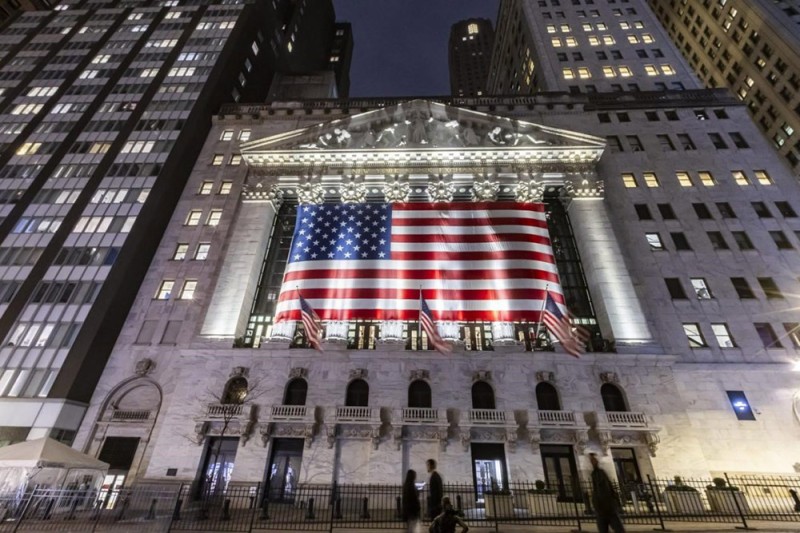
• 在唐纳德·特朗普出人意料地推出激进关税政策导致外资撤离仅一个月后,外国投资者于5月便大举回归美国股市和债市。最新数据显示,随着最高关税税率暂缓实施,为贸易谈判留出了喘息空间,外资净流入创历史纪录。此后美国股市已重拾历史高点,不过债券收益率仍居高不下。
正如美国消费者在唐纳德·特朗普的关税政策下展现出非凡韧性一样,外国投资者显然也对市场动荡有极强的承受能力。
美国财政部最新数据显示,5月份外国投资者净买入美国证券3,111亿美元,创下历史新高,而在4月份外资流出142亿美元。
布鲁金斯学会(Brookings Institution)高级研究员罗宾·布鲁克斯周三在其Substack上发表了一篇题为《‘美国例外主义’强势回归》的帖子。他在文中写道:“这一切值得关注,因为经过近几个月的动荡,众多评论员曾预言美国‘例外主义’的终结。现实情况是,市场对市场波动的接受程度远超人们想象。美国‘例外主义’依然存在且生机勃勃。”
他补充道,与此同时,在截至5月的12个月里,外国资本净流入量接近2023年7月创下的历史最高纪录(当时超过1.4万亿美元),标志着市场中美国例外主义叙事达到顶峰。
5月份的反弹标志着与4月份相比出现了惊人的逆转,当时华尔街曾担忧美国在全球经济和市场中的霸主地位即将终结。
在“解放日”之后,标普500指数一度濒临熊市,较此前高点暴跌近20%,而纳斯达克指数则已跌破该门槛。
10年期美国国债收益率最初大幅下挫,但随后在短短数日内飙升逾70个基点,因为投资者担心美国的主要债权国将抛售其持有的美债。
但一个月后,情况却截然相反。
布鲁克斯写道:“美国要经历真正的大规模资本外逃门槛很高,4月份显然没有突破。”
可以肯定的是,10年期国债收益率仍高于“解放日”前的水平,而美元也经历了50多年来最糟糕的上半年表现。
而且,尽管标普500指数和纳斯达克指数已收复失地并屡创新高,但欧洲和中国的股指表现仍优于美国的同类指数。
与此同时,与日本及其他贸易伙伴的谈判已敲定了高于最初10%基准的关税税率。与其他国家的谈判仍在进行中,若无法达成协议,关税税率可能进一步提高。
尽管如此,市场资深人士、Yardeni Research总裁埃德·亚德尼也对显示美国市场资金流入创纪录的数据备受鼓舞。
他在周一写道:“因此,我们从数据中得到慰藉,这些数据证实,痴心妄想的是那些认为美债、美股和美元将遭遇大规模抛售的看空者,而不是我们。最新的财政部数据也证实了我们相信‘陌生人的善意’是正确的。”
就在几个月前,华尔街重量级人物还在对特朗普的关税政策及其长期影响发出警告。
城堡投资(Citadel)创始人兼首席执行官肯·格里芬在4月份警告称,美国正在侵蚀其“品牌”。他解释道,从美国文化到其金融和军事实力,美国是全世界大多数人的向往之地。
他表示:“在金融市场上,没有哪个品牌能与美国国债的品牌相提并论……我们正在让这个品牌面临风险。”他补充道,消除一个品牌的污点需要很长时间。
5月,安联集团(Allianz)首席经济顾问穆罕默德·埃尔-埃利安表示,美国例外主义时代已“被按下暂停键”。
上个月,德意志银行(Deutsche Bank)表示,美国引以为豪的例外主义因为特朗普关税战而受到附带损害。
经济学家吉姆·里德在一份报告中写道:“我们的展望认为,美国例外主义的结构性基础,尤其是利用美元储备货币地位进行低成本融资的能力,已经开始出现削弱的迹象。因此,我们在结构上仍看空美元,并预计美国国债的期限溢价将持续上升。”(*)
译者:刘进龙
审校:汪皓
• 在唐纳德·特朗普出人意料地推出激进关税政策导致外资撤离仅一个月后,外国投资者于5月便大举回归美国股市和债市。最新数据显示,随着最高关税税率暂缓实施,为贸易谈判留出了喘息空间,外资净流入创历史纪录。此后美国股市已重拾历史高点,不过债券收益率仍居高不下。
正如美国消费者在唐纳德·特朗普的关税政策下展现出非凡韧性一样,外国投资者显然也对市场动荡有极强的承受能力。
美国财政部最新数据显示,5月份外国投资者净买入美国证券3,111亿美元,创下历史新高,而在4月份外资流出142亿美元。
布鲁金斯学会(Brookings Institution)高级研究员罗宾·布鲁克斯周三在其Substack上发表了一篇题为《‘美国例外主义’强势回归》的帖子。他在文中写道:“这一切值得关注,因为经过近几个月的动荡,众多评论员曾预言美国‘例外主义’的终结。现实情况是,市场对市场波动的接受程度远超人们想象。美国‘例外主义’依然存在且生机勃勃。”
他补充道,与此同时,在截至5月的12个月里,外国资本净流入量接近2023年7月创下的历史最高纪录(当时超过1.4万亿美元),标志着市场中美国例外主义叙事达到顶峰。
5月份的反弹标志着与4月份相比出现了惊人的逆转,当时华尔街曾担忧美国在全球经济和市场中的霸主地位即将终结。
在“解放日”之后,标普500指数一度濒临熊市,较此前高点暴跌近20%,而纳斯达克指数则已跌破该门槛。
10年期美国国债收益率最初大幅下挫,但随后在短短数日内飙升逾70个基点,因为投资者担心美国的主要债权国将抛售其持有的美债。
但一个月后,情况却截然相反。
布鲁克斯写道:“美国要经历真正的大规模资本外逃门槛很高,4月份显然没有突破。”
可以肯定的是,10年期国债收益率仍高于“解放日”前的水平,而美元也经历了50多年来最糟糕的上半年表现。
而且,尽管标普500指数和纳斯达克指数已收复失地并屡创新高,但欧洲和中国的股指表现仍优于美国的同类指数。
与此同时,与日本及其他贸易伙伴的谈判已敲定了高于最初10%基准的关税税率。与其他国家的谈判仍在进行中,若无法达成协议,关税税率可能进一步提高。
尽管如此,市场资深人士、Yardeni Research总裁埃德·亚德尼也对显示美国市场资金流入创纪录的数据备受鼓舞。
他在周一写道:“因此,我们从数据中得到慰藉,这些数据证实,痴心妄想的是那些认为美债、美股和美元将遭遇大规模抛售的看空者,而不是我们。最新的财政部数据也证实了我们相信‘陌生人的善意’是正确的。”
就在几个月前,华尔街重量级人物还在对特朗普的关税政策及其长期影响发出警告。
城堡投资(Citadel)创始人兼首席执行官肯·格里芬在4月份警告称,美国正在侵蚀其“品牌”。他解释道,从美国文化到其金融和军事实力,美国是全世界大多数人的向往之地。
他表示:“在金融市场上,没有哪个品牌能与美国国债的品牌相提并论……我们正在让这个品牌面临风险。”他补充道,消除一个品牌的污点需要很长时间。
5月,安联集团(Allianz)首席经济顾问穆罕默德·埃尔-埃利安表示,美国例外主义时代已“被按下暂停键”。
上个月,德意志银行(Deutsche Bank)表示,美国引以为豪的例外主义因为特朗普关税战而受到附带损害。
经济学家吉姆·里德在一份报告中写道:“我们的展望认为,美国例外主义的结构性基础,尤其是利用美元储备货币地位进行低成本融资的能力,已经开始出现削弱的迹象。因此,我们在结构上仍看空美元,并预计美国国债的期限溢价将持续上升。”(*)
译者:刘进龙
审校:汪皓
• Foreign investors returned to U.S. stocks and bonds in force in May, just a month after retreating in the wake of President Donald Trump’s unexpectedly aggressive tariffs. New data show record net inflows, as the highest tariff rates were on hold to allow breathing room for trade talks. U.S. stocks have since retaken record highs, though bond yields remain elevated.
Just as American consumers have demonstrated extraordinary resilience amid President Donald Trump’s tariffs, foreign investors apparently have a strong stomach for market chaos.
The most recent data from the Treasury Department shows that foreigners plowed a net $311.1 billion into U.S. securities in May, a record high, after pulling out $14.2 billion in April.
“All this is notable because so many commentators prophesied the end of US ‘exceptionalism’ after the turbulence of recent months,” Robin Brooks, a senior fellow at the Brookings Institution, wrote Wednesday in a post titled “US exceptionalism roars back” on his Substack. “The reality is that markets are far more accepting of all the ups and downs than people realize. US ‘exceptionalism’ is alive and well.”
Meanwhile, for the 12 months through May, net foreign inflows neared their all-time high from July 2023, when they topped $1.4 trillion to mark the peak of the American exceptionalism narrative in markets, he added.
The rebound in May signals a stunning turnaround from April, as Wall Street feared the end of U.S. supremacy in the global economy and markets.
In the immediate aftermath of “Liberation Day,” the S&P 500 flirted with a bear market, crashing nearly 20% from its prior high while the Nasdaq passed that threshold.
The 10-year Treasury yield initially plunged but then soared more than 70 basis points in just days as investors worried top U.S. debt holders would dump their holdings.
But a month later, the opposite happened.
“The hurdle for the US to experience genuine capital flight is high and certainly wasn’t breached in April,” Brooks wrote.
To be sure, the 10-year yield remains above its pre-Liberation Day level, and the dollar has suffered its worst first half in more than 50 years.
And while the S&P 500 and Nasdaq have retaken their prior records and continue to charge even higher, stock indexes in Europe and China are still outperforming U.S. rivals.
Meanwhile, talks with Japan and trade partners have cemented tariffs rates that are higher than the initial 10% baseline. Negotiations with other countries are still ongoing, and failure to reach a deal could send tariff rates even higher.
Nevertheless, market veteran Ed Yardeni, president of Yardeni Research, was also heartened by the data showing record inflows into U.S. markets.
“So, we take comfort from the data that confirm that it is the bears on the outlook for a massive selloff in US bonds, US equities, and the US dollar who might be delusional, not us,” he wrote on Monday. “Our faith in the kindness of strangers has been validated by the latest Treasury data.
Just a few months ago, top names on Wall Street were sounding the alarm on Trump’s tariffs and their long-term repercussions.
Citadel founder and CEO Ken Griffin warned in April that the country was eroding its “brand,” explaining that from American culture to its financial and military strength, the U.S. is an aspiration for most of the world.
“On the financial markets, no brand can compare to the brand of the U.S. Treasuries… we put that brand at risk,” he said, adding that it takes a very long time to remove the tarnish on a brand.
In May, Mohamed El-Erian, chief economic advisor at Allianz, said the era of U.S. exceptionalism has “been put on pause.”
And last month, Deutsche Bank said America’s prized exceptionalism is the collateral damage of Trump’s tariff war.
“Our outlook argues that the structural foundations of U.S. exceptionalism—particularly the ability to finance itself cheaply via the dollar’s reserve status—have begun to erode,” economist Jim Reid wrote in a note. “So we remain structurally bearish on the dollar and expect U.S. term premia to keep rising.”

